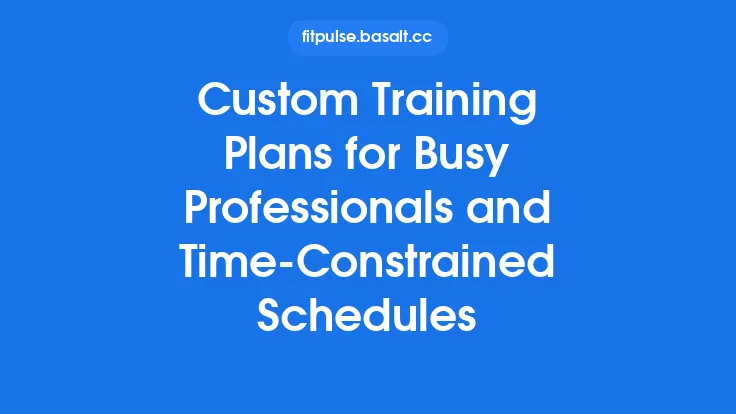Travel often feels like the ultimate test of a well‑crafted training program. One day you’re sprinting up a hill in the Alps, the next you’re navigating a cramped hotel room after a red‑eye flight. The challenge isn’t just finding a spare 30‑minute window—it’s building a training system that travels with you, adapts to unpredictable schedules, and still delivers progressive results. Below is a comprehensive guide to designing travel‑friendly training plans that fit seamlessly into an on‑the‑go lifestyle while honoring the core tenets of periodization, overload, and recovery.
Understanding the Travel Context
Before you can design a plan that works on the road, you need to map out the variables that differentiate travel from a home‑based routine.
| Variable | Typical Travel Scenario | Impact on Training |
|---|---|---|
| Location stability | Hotel, Airbnb, campsite, or a friend’s house | Limits access to fixed equipment; encourages portable solutions |
| Time zone shifts | Jet lag, daylight changes | Alters hormone rhythms, sleep quality, and perceived exertion |
| Daily itinerary | Meetings, sightseeing, layovers | Creates irregular activity windows and fluctuating energy levels |
| Environmental constraints | Small rooms, shared spaces, outdoor weather | Dictates exercise selection (e.g., bodyweight vs. equipment) |
| Stressors | Travel fatigue, unfamiliar food, schedule changes | Increases cortisol, potentially impairing recovery |
By cataloguing these factors for each trip—whether a week‑long business conference or a month‑long backpacking adventure—you can anticipate the training compromises you’ll need to make and embed flexibility directly into the program’s architecture.
Core Principles of Travel‑Friendly Program Design
- Modularity – Break the program into interchangeable “blocks” (e.g., strength, mobility, conditioning) that can be swapped in and out without breaking the overall progression.
- Scalable Overload – Use variables that can be adjusted without equipment: tempo, range of motion, unilateral work, and plyometric intensity.
- Periodized Flexibility – Incorporate built‑in “travel weeks” where volume and intensity are deliberately reduced to accommodate recovery from travel stress.
- Equipment Minimalism – Prioritize tools that weigh <2 kg and occupy <0.5 L of space (e.g., resistance bands, a pair of collapsible dumbbells, a suspension trainer).
- Environment Utilization – Treat stairs, park benches, playgrounds, and even hotel corridors as training assets.
When these principles are woven together, the resulting plan feels less like a rigid schedule and more like a resilient framework that can be reshaped on the fly.
Equipment‑Light Modalities
| Modality | Why It Works on the Road | Sample Progression |
|---|---|---|
| Resistance Bands | Portable, versatile, provide variable resistance throughout the range | Band‑assisted pull‑ups → banded rows → banded face pulls |
| Suspension Trainers (TRX, door‑anchor kits) | Anchor to doors, trees, or sturdy furniture; enable full‑body pulling and pushing | Inverted rows → single‑leg pistol squats → suspended push‑ups |
| Collapsible Dumbbells/Kettlebells | Adjustable weight in a compact shell; ideal for unilateral loading | Goblet squat → single‑arm press → weighted lunges |
| Bodyweight Progressions | No equipment needed; can be intensified via tempo, holds, or plyometrics | Standard push‑up → archer push‑up → clapping push‑up |
| Portable Plyo Boxes (foldable) | Small footprint; useful for jumps, step‑ups, and elevated core work | Box step‑ups → box jumps → Bulgarian split squats on box |
By selecting a core set of these tools before you travel, you guarantee that the majority of your program’s stimulus can be delivered anywhere.
Modular Workout Architecture
A modular approach treats each training session as a “plug‑and‑play” component. Below is a template for a four‑day split that can be rearranged based on daily constraints:
| Day | Primary Focus | Core Modules (choose 2–3) |
|---|---|---|
| A | Lower‑Body Strength | 1️⃣ Squat Variation (banded, goblet, pistol) 2️⃣ Hip‑Dominant Pull (banded good‑morning, single‑leg Romanian) 3️⃣ Core Stability (plank variations) |
| B | Upper‑Body Push | 1️⃣ Press Variation (banded overhead, floor press) 2️⃣ Horizontal Push (suspended push‑up, banded chest press) 3️⃣ Triceps/Shoulder Accessory |
| C | Conditioning / Mobility | 1️⃣ HIIT (battle‑rope substitute, band sprints) 2️⃣ Mobility Circuit (banded shoulder dislocates, hip flexor stretch) |
| D | Upper‑Body Pull | 1️⃣ Pull Variation (banded pull‑up, inverted row) 2️⃣ Vertical Pull (banded lat pull‑down) 3️⃣ Biceps/Rear‑Deltoid Accessory |
How to use it:
- Select the day that best matches the time you have that morning/evening.
- Swap modules if a particular movement is impractical (e.g., replace a squat with a single‑leg bridge if the floor is too soft).
- Maintain the overall weekly distribution of push/pull/legs to preserve muscular balance.
Because each module contains its own progressive overload scheme (e.g., increase band tension, add a tempo hold, or add a rep), you can keep advancing even when the exact exercise changes.
Periodization Adjustments for Travel Stress
Travel introduces acute stressors that can blunt adaptation if not accounted for. A micro‑periodization model—where each week is a “micro‑cycle” and each trip is a “macro‑cycle”—helps you align training intensity with physiological readiness.
- Pre‑Travel Build (1–2 weeks)
- Slightly increase volume (10–15 %) to create a training “buffer.”
- Emphasize mobility and joint stability to prepare for irregular surfaces.
- Travel Week (0–7 days)
- Volume: Reduce by 20–30 % (e.g., 3 sets instead of 4).
- Intensity: Keep relative load high (80 % of 1RM) but lower total reps.
- Recovery: Prioritize sleep hygiene and active recovery (light stretching, walking).
- Post‑Travel Re‑Integration (1–2 weeks)
- Gradually restore volume over 3–4 sessions.
- Use “deload” techniques (e.g., slower tempo, increased rest) to monitor fatigue.
- Re‑assess performance metrics (e.g., squat depth, push‑up count) to gauge any regression.
By embedding these phases into the program’s calendar, you avoid the “all‑or‑nothing” mentality that often leads to missed sessions or overtraining during travel.
Recovery Strategies on the Road
Recovery is the hidden pillar of any training plan, and travel can erode it silently. Here are evidence‑based tactics that fit into a suitcase:
| Strategy | Implementation Tips |
|---|---|
| Sleep Optimization | Use blackout curtains or a sleep mask; keep a consistent bedtime relative to the local time zone; consider melatonin (0.5 mg) for rapid circadian adjustment. |
| Compression & Mobility | Pack a lightweight compression sleeve for calves; perform a 5‑minute dynamic mobility routine each morning (hip circles, shoulder pass‑throughs). |
| Cold/Heat Contrast | A collapsible silicone ice pack can be frozen in a hotel freezer; a hot shower followed by a 2‑minute cold rinse improves circulation and reduces delayed‑onset muscle soreness. |
| Hydration Management | Carry a reusable 500 ml bottle; add electrolyte tablets when traveling to hot climates or after long flights. |
| Active Recovery Walks | Use airport layovers or hotel corridors for brisk walks; aim for 10–15 minutes of low‑intensity movement to stimulate blood flow without taxing the nervous system. |
These low‑tech recovery tools complement the training plan and help maintain performance despite the inevitable disruptions of travel.
Nutrition and Hydration Considerations
While the article’s focus is training design, nutrition is inseparable from performance, especially when you’re away from your usual kitchen.
- Protein Portability: Pack single‑serve whey or plant‑based protein packets (20 g per serving) that dissolve in water. This ensures you meet daily protein targets (≈1.6–2.2 g/kg body weight) even when meals are irregular.
- Smart Carbohydrate Timing: Prioritize complex carbs (oats, whole‑grain wraps) for pre‑travel meals to sustain glycogen stores; use simple carbs (fruit, honey) immediately post‑workout for rapid replenishment.
- Micronutrient Safeguard: A multivitamin can fill gaps caused by limited fresh produce; consider vitamin D supplementation if you’re traveling to high‑latitude regions with limited sunlight.
- Meal Planning Apps: While not the focus, a simple note‑taking app can help you log meals and ensure you’re not consistently in a caloric deficit, which would impair recovery.
Leveraging the Environment
Every destination offers unique training assets. Turning the environment into a gym expands your exercise repertoire without adding weight to your luggage.
- Staircase Intervals: Use hotel or building stairs for high‑intensity interval training—30 seconds sprint up, 30 seconds walk down, repeat 8–10 times.
- Park Bench Strength: Perform Bulgarian split squats, incline push‑ups, or triceps dips using a sturdy bench.
- Beach Sand Conditioning: Sand adds instability, increasing activation of stabilizer muscles during lunges, burpees, or sprint drills.
- Urban Climbing: Look for low walls, railings, or playground equipment to practice pull‑ups, hanging leg raises, or farmer’s walks (using a loaded backpack).
By scouting these resources ahead of time (Google Maps “parks,” hotel photos, or local tourism sites), you can pre‑plan workouts that feel fresh and engaging.
Psychological Resilience and Consistency
Travel can be mentally draining, and motivation often wanes when you’re out of routine. Embedding psychological strategies into the training plan helps sustain adherence.
- Goal Chunking: Break the overall training objective into “trip‑specific” micro‑goals (e.g., “complete three full‑body sessions this week”). Celebrate each micro‑goal to reinforce progress.
- Visualization: Spend 2 minutes before sleep visualizing the next workout—this primes neural pathways and reduces the mental barrier of starting a session in an unfamiliar setting.
- Social Anchors: If you’re traveling with colleagues or friends, schedule a joint workout (even a 20‑minute bodyweight circuit). The social contract boosts accountability.
- Self‑Compassion: Accept that some days will be sub‑optimal. Rather than scrapping the entire plan, shift to a “maintenance” mode (e.g., a light mobility session) and resume full intensity when conditions improve.
These mental tools are as portable as a resistance band and can be practiced anywhere.
Sample Weekly Travel‑Ready Templates
Below are two ready‑to‑use weekly outlines. Adjust the order of days based on your itinerary; the progression logic remains intact.
Template A – “Business Trip (4‑Day Stay)”
| Day | Session | Core Modules (choose 2) | Sets × Reps | Notes |
|---|---|---|---|---|
| Mon | Lower‑Body Strength | Goblet Squat (banded) + Single‑Leg Romanian (band) | 3 × 8‑10 | Keep tempo 3‑1‑2 (eccentric‑pause‑concentric) |
| Tue | Upper‑Body Push | Suspended Push‑up + Band‑Resisted Overhead Press | 3 × 10‑12 | Add 2‑second hold at bottom for extra time under tension |
| Wed | Conditioning | Staircase Intervals (30 s up/30 s down) + Core Circuit (plank variations) | 8 rounds + 3 × 30 s each | Maintain HR at 70‑80 % max |
| Thu | Upper‑Body Pull | Inverted Row + Band‑Assisted Pull‑up | 3 × 8‑10 | Finish with band face pulls for shoulder health |
| Fri | Active Recovery | Light mobility flow + 15‑minute walk | — | Prioritize sleep and hydration |
Template B – “Backpacking Adventure (7‑Day Trek)”
| Day | Session | Core Modules (choose 2) | Sets × Reps | Notes |
|---|---|---|---|---|
| Day 1 | Full‑Body Strength | Pistol Squat (assisted) + Band Pull‑Apart | 3 × 6‑8 each | Use a backpack (5 kg) for added load if needed |
| Day 2 | Conditioning | Hill Sprints (10 × 15 s) + Core (hollow hold) | 10 × 15 s + 3 × 30 s | Keep rest 45 s between sprints |
| Day 3 | Upper‑Body Push | Decline Push‑up (feet on rock) + Band Chest Press | 3 × 10‑12 | Emphasize full range of motion |
| Day 4 | Rest / Mobility | Stretching + foam‑roll (if available) | — | Focus on hip flexors and calves |
| Day 5 | Upper‑Body Pull | Single‑Arm Row (using a filled water bottle) + Band Lat Pull‑Down | 3 × 8‑10 | Keep tension high throughout |
| Day 6 | Full‑Body Circuit | 5‑minute AMRAP: 10 × Air Squat, 10 × Push‑up, 10 × Band Row | 3 rounds | Adjust reps based on fatigue |
| Day 7 | Light Recovery | Easy hike + breathing exercises | — | Re‑hydrate and refuel protein‑rich foods |
Both templates illustrate how the same modular components can be rearranged to suit a short business trip or an extended outdoor expedition.
Monitoring Progress Without Disruption
Tracking should be simple enough to fit into a suitcase. Here are three low‑tech methods:
- Workout Log Sheet – A single A4 page with columns for exercise, sets, reps, and “RPE” (Rate of Perceived Exertion). Write on the back of a boarding pass or a hotel receipt.
- Progress Photo Calendar – Take a quick photo each morning (same lighting, same pose). Over weeks you’ll see visual changes even if you can’t log exact numbers.
- Performance Benchmarks – Choose two or three “test” movements (e.g., max push‑ups in 60 seconds, longest plank hold). Re‑test every 4–6 weeks to gauge strength and endurance trends.
Because the data collection is minimal, you won’t be tempted to skip workouts just to avoid logging, and you’ll still have enough information to adjust load, volume, or exercise selection.
Bringing It All Together
Designing a training plan that thrives while you’re on the move isn’t about cramming every possible exercise into a suitcase. It’s about strategic modularity, portable overload, and context‑aware periodization. By:
- Mapping travel‑specific stressors,
- Selecting equipment‑light modalities,
- Building interchangeable workout blocks,
- Adjusting volume and intensity around travel weeks,
- Prioritizing recovery, nutrition, and mental resilience,
you create a system that delivers consistent, measurable progress regardless of airport layovers, hotel room sizes, or time‑zone shifts. The result is a training program that feels as natural as packing a toothbrush—essential, reliable, and ready for any destination.





